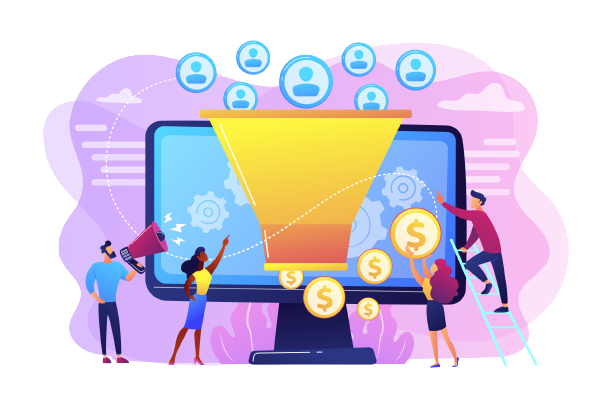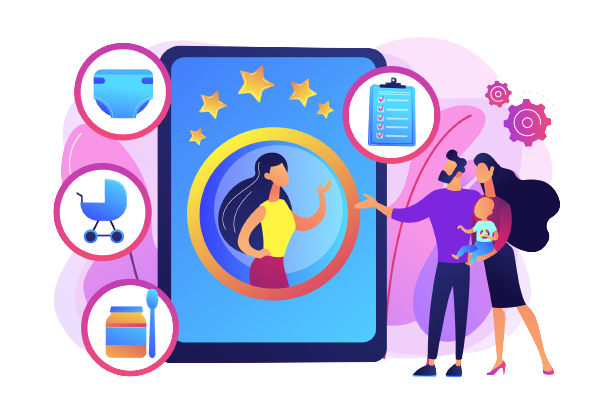
We’re living in a hyper-competitive e-commerce landscape where customers have more choices than ever before, and the power of personalization cannot be overstated. Think of it as your favorite local store, where the owner knows your preferences and makes every visit special. That’s the magic of Customer Segmentation Automation, and we’re here to break it down for you.
In this blog, we’re going to discuss strategies that can supercharge your online shopping journey. We’ll talk about the kind of technology that doesn’t just follow trends but sets new ones. It’s all about creating online shopping experiences that feel like they were custom-made just for you.
So, whether you’re new to the world of e-commerce and want to understand how it all works, or looking for ways to create better deals and personalized recommendations based on customer segmentation, get ready. Automate customer segmentation to get a peek behind the curtain of e-commerce success. Let’s dive right into this blog!
Introduction to Customer Segmentation in E-commerce

In the vast and highly competitive world of e-commerce, understanding your customers on a deep level is paramount to success. Customer segmentation is a strategic approach that empowers e-commerce businesses to do just that. It involves categorizing your customer base into distinct groups based on shared characteristics, behaviors, and preferences. This method of analysis has proven to be a game-changer for e-commerce businesses, allowing them to personalize marketing efforts, streamline operations, and ultimately boost profitability.
Why Customer Segmentation Matters for E-commerce

Customer segmentation isn’t just a buzzword; it’s a fundamental strategy that can make or break your e-commerce venture. Here’s why it matters:
- Targeted Marketing: One-size-fits-all marketing strategies are becoming increasingly ineffective. With customer segmentation, you can create targeted marketing campaigns tailored to specific customer groups. This means you can send relevant product recommendations, promotions, and content that resonates with each segment, significantly increasing your chances of conversion.
- Enhanced Customer Experience: Customers today expect a personalized shopping experience. When you understand your customers’ preferences and behaviors, you can offer them a seamless and personalized journey. This includes showing them the right products, providing relevant content, and offering tailored incentives, leading to higher customer satisfaction and loyalty.
- Optimized Product Offerings: Through segmentation, you can gain insights into which products are popular among specific customer groups. This knowledge can guide your product development and inventory management decisions. You can stock items that are more likely to sell to certain segments, reducing inventory costs and increasing turnover.
- Improved Customer Retention: It’s often more cost-effective to retain existing customers than acquire new ones. Customer segmentation helps you identify and engage with high-value customers, enabling you to create retention strategies specifically tailored to their needs and preferences. This can lead to increased customer lifetime value.
- Better Marketing ROI: Segmentation helps you allocate your marketing budget more efficiently. Instead of spreading your resources thin across all customer groups, you can focus your efforts and resources on segments that have a higher likelihood of conversion. This results in a better return on investment (ROI) for your marketing campaigns.
Benefits of Implementing Customer Segmentation

Now that we’ve discussed why customer segmentation matters, let’s find out the tangible benefits of implementing this strategy in your e-commerce business:
- Increased Sales: By delivering personalized offers and recommendations to different customer segments, you’re more likely to convert potential buyers into paying customers. This leads to a boost in sales revenue.
- Cost Savings: Targeted marketing reduces wasted resources on customers who are less likely to engage or make a purchase. You can allocate your budget more efficiently, reducing marketing costs.
- Enhanced Customer Loyalty: Personalized experiences foster customer loyalty. When customers feel understood and valued, they are more likely to return to your e-commerce store for future purchases.
- Data-Driven Decision-Making: Customer segmentation relies on data analysis. This data-driven approach enables you to make informed decisions regarding product offerings, pricing, marketing strategies, and inventory management.
- Competitive Advantage: E-commerce is highly competitive. Implementing customer segmentation can set your business apart from competitors by offering a more personalized and engaging shopping experience.
Customer segmentation is not just a concept; it’s a powerful tool that can significantly impact your e-commerce business’s success. By understanding the unique needs and preferences of your customers and tailoring your strategies accordingly, you can achieve higher sales, increased customer loyalty, and a competitive edge in the market.
Key Strategies for Effective Customer Segmentation in E-commerce

Customer segmentation is a critical aspect of e-commerce marketing. It enables you to tailor your marketing efforts to specific groups of customers, resulting in higher engagement, increased conversions, and ultimately, improved revenue. Here are three key strategies for effective customer segmentation in e-commerce:
Leveraging Automation Tools and Software
In the fast-paced world of e-commerce, manually segmenting your customer base can be time-consuming and error-prone. This is where automation tools and software come into play. By automating the process of customer segmentation, you can save time, reduce human error, and ensure that your marketing efforts are always targeted and up-to-date.
Benefits of Automation Tools and Software:
- Real-time Segmentation: Automation allows you to segment customers in real time based on their behavior, purchase history, and interactions with your website.
- Scalability: As your e-commerce business grows, automation tools can handle larger datasets and more complex segmentation criteria.
- Consistency: Automation ensures that segmentation is consistent across all marketing channels, from email campaigns to personalized website content.
- Personalization: With automation, you can deliver highly personalized experiences to each segment, increasing the chances of conversion.
Popular automation tools for customer segmentation include customer relationship management (CRM) software, marketing automation platforms, and e-commerce analytics tools. These tools often provide pre-built segmentation templates and allow you to create custom segmentation criteria based on various factors such as demographics, purchase history, and browsing behavior.
- Data Collection and Analysis for Segmentation
Effective customer segmentation relies on accurate and relevant data. To segment your customer base effectively, you need to collect and analyze data from various sources, including your e-commerce website, social media, email campaigns, and customer interactions. Here’s how to approach data collection and analysis for segmentation:
Data Collection:
- Customer Profiles: Start by collecting basic information about your customers, such as name, email address, location, and demographics.
- Behavioral Data: Track customer behavior on your website, including pages visited, products viewed, and items added to the cart.
- Purchase History: Maintain records of previous purchases, order frequency, and purchase values.
- Feedback and Surveys: Gather customer feedback through surveys and reviews to understand preferences and pain points.
Data Analysis:
- Segmentation Criteria: Identify key criteria for segmentation, such as age, gender, location, purchase frequency, and product preferences.
- Segment Identification: Use data analysis tools to group customers based on these criteria. You can employ techniques like clustering and classification algorithms.
- Segment Refinement: Continuously refine your segments based on performance metrics, ensuring they remain relevant and effective.
- Predictive Analytics: Consider using predictive analytics to anticipate future customer behavior and adjust your segmentation strategies accordingly.
- Creating Customer Personas for Targeting
Customer personas are fictional representations of your ideal customers within specific segments. They help you understand your audience on a deeper level and guide your marketing efforts. Here’s how to create customer personas for targeting:
- Research: Start by conducting market research and analyzing your existing customer data to identify common traits and behaviors within each segment.
- Persona Creation: Develop detailed personas for each segment, including information such as age, gender, job title, goals, challenges, and shopping preferences.
- Mapping Customer Journeys: Understand the customer journey for each persona, from awareness to purchase and post-purchase interactions.
- Tailored Content: Create content, marketing messages, and offers that resonate with each persona’s needs and preferences.
- Testing and Optimization: Continuously test and optimize your persona-based marketing strategies to improve engagement and conversion rates.
These key strategies ensure that your marketing efforts are not only efficient but also highly targeted, ultimately leading to a more satisfied customer base and increased revenue.
Implementing Automated Email Marketing Campaigns

Automated email marketing campaigns are a powerful tool for engaging with your e-commerce customers in a highly personalized and efficient way. In this segment, we will explore three key strategies within this category:
- Tailoring Email Content to Segments
Segmentation is at the heart of any successful email marketing strategy. It involves dividing your email list into distinct segments based on various criteria such as demographics, purchase history, browsing behavior, and engagement levels. By tailoring email content to these segments, you can send messages that are highly relevant to each group of recipients.
Why Tailoring Matters:
- Personalization: Tailored content shows your customers that you understand their specific needs and preferences.
- Higher Engagement: Segmented emails typically have higher open and click-through rates.
- Improved Conversions: Relevance leads to more meaningful interactions, potentially increasing sales and conversions.
How to Implement:
- Data Collection: Gather data on your customers’ behavior and preferences.
- Segment Creation: Divide your email list into meaningful segments.
- Content Customization: Craft email content that speaks directly to the interests and needs of each segment.
- A/B Testing: Test different content variations to determine what resonates best with each segment.
- Automation for Abandoned Cart Recovery
Cart abandonment is a common challenge in e-commerce. Many customers add items to their cart but leave the website before completing the purchase. Automated email campaigns can help recover these potentially lost sales.
Why Abandoned Cart Recovery Matters:
- Revenue Boost: Recovering abandoned carts can significantly increase your revenue.
- Reminder Function: Automated emails remind customers of their abandoned items.
- Incentives: You can offer discounts or incentives to encourage the completion of the purchase.
How to Implement:
- Triggered Emails: Set up automated emails triggered when a customer leaves items in their cart.
- Persuasive Copy: Craft compelling email content with a clear call to action.
- Timing: Experiment with timing, sending reminders at strategic intervals.
- A/B Testing: Optimize email content and subject lines for better results.
- Personalized Product Recommendations
Personalization extends beyond addressing customers by their names. It involves recommending products based on individual preferences and behaviors, and it can significantly impact your e-commerce sales.
Why Personalized Recommendations Matter:
- Improved User Experience: Customers appreciate tailored product suggestions.
- Increased Sales: Relevant product recommendations can drive additional purchases.
- Customer Loyalty: Personalization can foster long-term customer relationships.
How to Implement:
- Data Analysis: Analyze customer data to understand buying patterns and preferences.
- Recommendation Algorithms: Use algorithms to suggest products related to what a customer has viewed or purchased.
- Email Integration: Include personalized recommendations in your automated email campaigns.
- Monitoring and Refinement: Continuously monitor the effectiveness of recommendations and refine your approach.
By delivering content that speaks directly to your customers’ needs, you can build stronger connections and drive more sales.
Optimizing Website and User Experience Through Segmentation
- Customizing Landing Pages for Segments
Customizing landing pages for different customer segments is a powerful way to enhance user experience and boost conversion rates in your e-commerce business. Here’s how you can effectively implement this strategy:
- Segment Identification: Begin by identifying the key customer segments based on factors like demographics, behavior, purchase history, and preferences. These segments could include new visitors, loyal customers, high-value shoppers, or users with specific interests.
- Content Personalization: Once you’ve identified your segments, tailor the content, images, and offers on your landing pages to align with the interests and needs of each group. For example, if you have a segment of outdoor enthusiasts, feature outdoor-related products and content on their landing page.
- Clear Calls to Action (CTAs): Ensure that your landing pages have clear and compelling CTAs that guide visitors towards desired actions, such as making a purchase, signing up for a newsletter, or downloading a resource.
- A/B Testing: Continuously test different landing page variations for each segment to determine which designs, copy, and offers resonate the most with your target audience. This iterative approach helps you refine your landing pages over time.
- Dynamic Content: Consider using dynamic content blocks that automatically adjust based on the user’s segment. Dynamic content can display personalized product recommendations, promotions, or messaging, enhancing relevance and engagement.
- Performance Monitoring: Use web analytics tools to track the performance of your segmented landing pages. Monitor metrics like bounce rate, conversion rate, and revenue generated to assess the effectiveness of your customization efforts.
- Dynamic Pricing Strategies
Dynamic pricing is a pricing strategy that involves adjusting product prices in real time based on various factors, including demand, competition, and customer behavior. Here’s how you can use dynamic pricing effectively:
- Data Analysis: Start by collecting and analyzing data related to customer behavior, market conditions, competitor pricing, and internal factors. This data will serve as the foundation for your dynamic pricing algorithms.
- Segmented Pricing: Implement different pricing strategies for various customer segments. For example, you might offer loyal customers exclusive discounts or adjust prices based on a customer’s past purchase history.
- Real-time Updates: Use pricing automation tools to update product prices in real time. This can be particularly effective during flash sales, promotions, or peak demand periods.
- Competitor Monitoring: Keep an eye on your competitors’ pricing strategies and adjust your prices accordingly to remain competitive. Dynamic pricing tools can help automate this process.
- A/B Testing: Continuously test different pricing strategies and monitor their impact on sales and profitability. Experiment with factors like discounts, bundling, and tiered pricing to find the most effective approach for each segment.
- A/B Testing and Segmentation
A/B testing is a vital component of optimizing user experiences through segmentation. It allows you to experiment with different variations of your website and marketing strategies to determine what resonates best with specific customer segments. Here’s how to leverage A/B testing effectively:
- Hypothesis Creation: Start by forming clear hypotheses about what you want to test. For instance, you might hypothesize that a different headline or CTA will improve conversion rates for a particular customer segment.
- Test Design: Create A/B tests that specifically target the identified segments. This might involve designing different versions of web pages, email campaigns, or product recommendations tailored to each segment.
- Randomization: Ensure that your A/B tests are conducted with proper randomization to eliminate bias. Randomly assign visitors or users to different test groups.
- Data Collection: Use analytics tools to gather data on how each test group performs. Pay attention to key metrics like conversion rate, click-through rate, and revenue generated.
- Statistical Analysis: Analyze the results using statistical methods to determine whether the differences observed are statistically significant. This will help you make data-driven decisions about which variations are most effective for each segment.
- Iterative Optimization: Continue to iterate and refine your website and marketing strategies based on the insights gained from A/B testing. Implement the most successful variations as the new standard for each segment.
By implementing these strategies effectively, you can enhance the user experience on your e-commerce website, drive higher conversion rates, and ultimately achieve greater success in your business.
The Future of Customer Segmentation in E-commerce

In the fast-paced world of e-commerce, staying ahead of the competition and meeting customer expectations are paramount. Customer segmentation has long been a key strategy in e-commerce, enabling businesses to tailor their marketing efforts to specific groups of customers. However, the future of customer segmentation in e-commerce promises to be even more dynamic and impactful. In this article, we will explore the evolving landscape of customer segmentation in e-commerce and what lies ahead.
- Personalization at Scale
While personalization is not a new concept in e-commerce, the future will see businesses taking personalization to a whole new level. Instead of just addressing customers by their first names in emails, e-commerce platforms will use advanced algorithms and artificial intelligence (AI) to create highly personalized shopping experiences.
Imagine a scenario where a customer visits an online fashion store, and the website instantly adapts to their preferences, showcasing products, colors, and styles that align with their past purchases and browsing history. This level of personalization will be driven by data analysis and real-time machine learning, ensuring that every customer interaction feels tailored to their unique tastes.
- Predictive Analytics for Hyper-Targeting
Predictive analytics is poised to revolutionize customer segmentation in e-commerce. By analyzing historical data, predictive models will anticipate what customers are likely to purchase next. This will enable businesses to send targeted offers and recommendations before customers even start searching for products.
For example, if a customer has a history of buying outdoor gear in the winter, a predictive analytics system might suggest winter clothing and accessories even before the customer starts shopping. This proactive approach not only increases sales but also enhances the customer’s shopping experience.
- Cross-Channel and Seamless Integration
The future of customer segmentation will involve breaking down the silos between various marketing channels. E-commerce businesses will seamlessly integrate data from social media, email marketing, mobile apps, and website interactions to create a holistic view of each customer. This unified data will drive more accurate and effective segmentation.
Imagine a scenario where an e-commerce company can identify a customer’s preferred communication channel and tailor messages accordingly. For instance, if a customer is more responsive to SMS than email, the system will prioritize sending promotions and updates via SMS. This level of integration will enhance the overall customer journey and drive higher conversion rates.
- Ethical Considerations in Automation
As e-commerce businesses rely more on automation for customer segmentation, there will be a growing emphasis on ethical considerations. Customer data privacy and consent will become even more critical. Businesses will need to ensure that they are using customer data responsibly and transparently, adhering to evolving data protection regulations.
Moreover, ethical customer segmentation will also extend to avoiding biases in AI and machine learning algorithms. Ensuring fairness in how different customer groups are targeted will be essential to maintain trust and avoid potential controversies.
- Hyper-Personalization for B2B E-commerce
While personalization has traditionally been associated with B2C e-commerce, the future will witness a surge in hyper-personalization for B2B e-commerce as well. Businesses selling to other businesses will use advanced marketing automation segmentation to cater to the unique needs and preferences of their corporate clients. This could involve personalized catalogs, pricing, and account management strategies.
E-commerce businesses that embrace these advancements and prioritize customer-centric strategies will likely thrive in an increasingly competitive online marketplace. As technology continues to evolve, businesses must stay agile and adapt to the changing expectations of their customers.
Conclusion: Building a Profitable E-commerce Business with Customer Segmentation Automation
Taking benefit of customer segmentation automation is no longer an option but a necessity for building a profitable e-commerce business. By implementing key strategies and embracing advanced techniques, you can tailor your marketing efforts to individual customer segments, enhancing user experiences, boosting sales, and ensuring long-term success. Stay updated with emerging trends and technologies, and always prioritize ethical considerations to maintain a competitive edge in the dynamic e-commerce landscape. With the right tools and practices, your e-commerce venture can thrive and prosper through the power of customer segmentation automation.